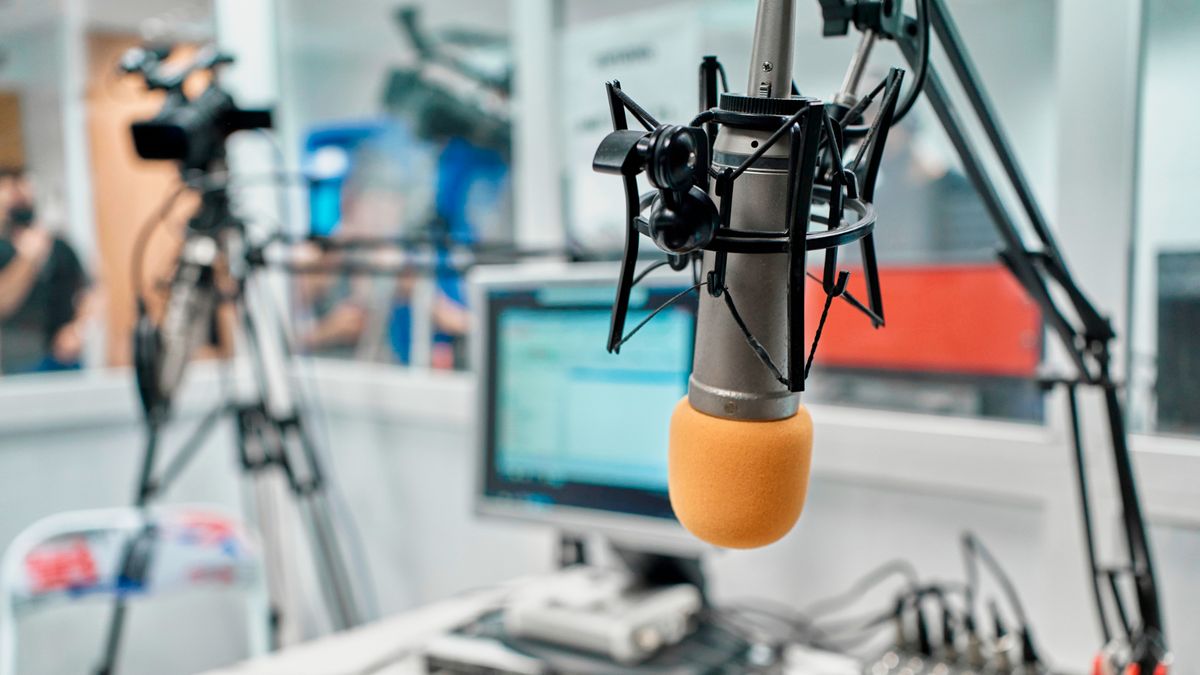Home>Devices & Equipment>Microphone>How To Make A Microphone Stand


Microphone
How To Make A Microphone Stand
Published: February 17, 2024
Learn how to make a sturdy and adjustable microphone stand at home with simple materials. Create a custom solution for your recording needs.
(Many of the links in this article redirect to a specific reviewed product. Your purchase of these products through affiliate links helps to generate commission for AudioLover.com, at no extra cost. Learn more)
Table of Contents
Introduction
Introduction
Creating your own microphone stand can be a rewarding and cost-effective project, especially if you are a musician, podcaster, or content creator. Building a custom microphone stand allows you to tailor it to your specific needs and preferences, and it can also be a fun and fulfilling DIY endeavor. In this guide, we will walk you through the step-by-step process of making a microphone stand using readily available materials.
Whether you’re a musician looking for a unique stand for your performances or a podcaster seeking a personalized setup for your recordings, crafting your own microphone stand can be a great solution. Not only does it offer a sense of satisfaction and creativity, but it also provides the opportunity to save money compared to purchasing a pre-made stand.
By following this guide, you will have the chance to unleash your creativity and customize a microphone stand that perfectly suits your needs. So, gather your materials and get ready to embark on this enjoyable and practical DIY project!
Materials Needed
Materials Needed
Before you begin crafting your own microphone stand, it’s essential to gather all the necessary materials. Here’s a list of items you’ll need for this project:
- PVC pipe (1 inch in diameter)
- PVC T-shaped connectors (2)
- PVC elbow connectors (2)
- PVC cross connectors (1)
- Microphone boom arm
- Microphone clip
- Measuring tape
- Saw or PVC pipe cutter
- Marker
- Sandpaper
- Optional: Spray paint for customization
Gathering these materials will ensure that you have everything you need to assemble your custom microphone stand. Once you have these items on hand, you’ll be ready to move on to the next steps of the construction process.
Step 1: Cutting the PVC Pipe
Step 1: Cutting the PVC Pipe
The first step in creating your own microphone stand is cutting the PVC pipe to the appropriate lengths. Start by determining the desired height for your stand. Using a measuring tape and marker, mark the PVC pipe at the desired height for the stand’s vertical section. This will typically be the length from the floor to the desired height of the microphone.
Next, use a saw or PVC pipe cutter to carefully cut the pipe at the marked location. It’s important to ensure that the cut is straight and even to allow for proper assembly later on. If needed, use sandpaper to smooth out any rough edges from the cut.
Additionally, you’ll need to cut a shorter section of PVC pipe to serve as the horizontal boom arm support. Measure and mark the appropriate length for this section, and then make a clean cut using the saw or pipe cutter. This piece will be attached to the vertical section of the stand to support the microphone’s boom arm.
By accurately cutting the PVC pipe to the required lengths, you’ll lay the foundation for assembling the main structure of your custom microphone stand. This step is crucial for ensuring that the stand is sturdy and tailored to your specific height preferences.
Step 2: Assembling the Base
Step 2: Assembling the Base
Once you have cut the PVC pipe to the appropriate lengths, the next step is to assemble the base of the microphone stand. This will provide stability and support for the entire structure. To do this, you will need the PVC T-shaped connectors and PVC elbow connectors.
Begin by inserting the cut vertical section of the PVC pipe into one of the T-shaped connectors. This will serve as the central point of the base. Then, attach the PVC elbow connectors to the bottom of the T-shaped connector, ensuring that they are positioned perpendicular to the vertical section. These elbow connectors will provide the necessary stability for the base to stand upright.
Next, insert the shorter horizontal section of PVC pipe into the open ends of the elbow connectors. This will create the base of the microphone stand, forming a stable and balanced foundation for the entire structure. Ensure that all the connections are secure and the pipes are aligned properly to maintain stability.
By assembling the base in this manner, you will establish a solid foundation for the microphone stand, ensuring that it remains steady and upright during use. This step is essential for laying the groundwork for the rest of the assembly process.
Step 3: Attaching the Boom Arm
Step 3: Attaching the Boom Arm
Attaching the boom arm to your custom microphone stand is a crucial step that allows for versatility and adjustability during recordings or performances. The boom arm provides the flexibility to position the microphone precisely where you need it, making it an essential component of the stand.
To attach the boom arm, you will need a PVC cross connector and the microphone boom arm itself. Begin by inserting the boom arm into one of the openings of the PVC cross connector. Ensure that it fits securely and aligns with the center of the cross connector.
Next, attach the PVC cross connector to the top of the vertical section of the microphone stand. This will allow the boom arm to extend horizontally from the stand, providing the flexibility to position the microphone as needed. Ensure that the connection is stable and that the boom arm is securely in place.
Once the boom arm is attached, you can adjust its position and angle to accommodate various recording or performance setups. This flexibility is a key advantage of incorporating a boom arm into your custom microphone stand, as it allows for precise microphone placement and easy adjustments during use.
By attaching the boom arm in this manner, you’ll enhance the functionality and versatility of your homemade microphone stand, making it well-suited for a wide range of recording and performance scenarios.
Step 4: Adding the Microphone Clip
Step 4: Adding the Microphone Clip
Adding a microphone clip to your custom stand is essential for securely holding the microphone in place during use. The microphone clip provides stability and ensures that the microphone remains in the desired position, allowing for optimal sound capture. To add the microphone clip, follow these steps:
- Begin by selecting a suitable microphone clip that is compatible with your microphone model. Ensure that the clip is designed to securely hold your specific microphone without causing any damage.
- Once you have the appropriate microphone clip, attach it to the end of the boom arm. Most microphone clips feature a threaded attachment that can be easily screwed onto the end of the boom arm.
- Ensure that the microphone clip is securely fastened to the boom arm, providing a stable and reliable mount for your microphone.
- Test the microphone clip by gently placing your microphone into it and ensuring that it fits snugly and securely. Make any necessary adjustments to the clip to ensure that the microphone is held firmly in place.
By adding the microphone clip to your custom microphone stand, you’ll create a secure and reliable mounting solution for your microphone. This step is crucial for ensuring that the microphone remains in the desired position during recordings or performances, allowing for optimal sound capture and performance flexibility.
Step 5: Final Adjustments
Step 5: Final Adjustments
After assembling the main components of your custom microphone stand, it’s time to make final adjustments to ensure that it meets your specific requirements and provides the functionality you need. This step involves fine-tuning the stand to accommodate your preferred microphone positioning and overall usage.
Here are some key considerations for making final adjustments to your microphone stand:
- Height Adjustment: Adjust the vertical section of the stand to achieve the desired height for your microphone. This will depend on your personal preference and the specific requirements of your recording or performance setup.
- Boom Arm Positioning: Experiment with the positioning and angle of the boom arm to find the optimal placement for your microphone. This will allow you to customize the stand to suit different recording scenarios.
- Stability Check: Ensure that all connections are secure and the stand is stable. Make any necessary adjustments to prevent wobbling or instability during use.
- Microphone Compatibility: Verify that the microphone clip securely holds your microphone without causing any damage. Make adjustments if needed to ensure a snug and safe fit.
By carefully making these final adjustments, you’ll tailor the microphone stand to your specific needs and preferences, ensuring that it provides the functionality and versatility required for your recording or performance activities.
Conclusion
Conclusion
Building your own custom microphone stand is a rewarding and practical endeavor that offers a range of benefits for musicians, podcasters, content creators, and audio enthusiasts. By following the steps outlined in this guide, you have the opportunity to create a personalized microphone stand that perfectly aligns with your specific requirements and preferences.
Through the use of readily available materials such as PVC pipe and connectors, along with a microphone boom arm and clip, you can craft a sturdy and versatile stand that provides the flexibility to position your microphone precisely where you need it. This DIY approach not only allows for cost savings compared to purchasing a pre-made stand but also offers the satisfaction of creating a unique and tailored solution.
By cutting the PVC pipe to the desired lengths, assembling the base, attaching the boom arm, adding the microphone clip, and making final adjustments, you’ve taken the necessary steps to construct a functional and personalized microphone stand. This stand can enhance your recording and performance experiences by providing stability, adjustability, and versatility.
Whether you’re a musician seeking a reliable stand for live performances, a podcaster in need of a customizable setup for recording sessions, or an audio enthusiast looking to personalize your equipment, creating your own microphone stand empowers you to design a solution that meets your exact specifications.
Embrace the creativity and practicality of DIY projects, and enjoy the benefits of using a microphone stand that you’ve crafted with your own hands. This custom stand will not only serve as a valuable tool for your audio endeavors but also stand as a testament to your resourcefulness and ingenuity in finding practical solutions.











